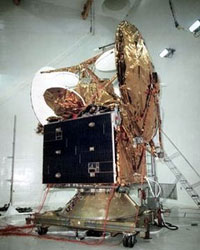 Photo courtesy NASACommercial space launches
are primarily used to place
communications satellites in orbit. |
Not only does the FAA regulate U.S. airspace, it ensures air travel safety by creating and enforcing airport and airline safety and security guidelines. In addition, the FAA is the licensing authority for
U.S. aircraft pilots, making certain that they meet the minimum requirements necessary for safe and knowledgeable operation of a particular class of aircraft.
The primary regulation of airspace occurs through the air traffic management system discussed in the previous section. Air traffic controllers follow guidelines established by the FAA for everything from the distance between aircraft to the radio frequencies they use to communicate.
In the United States, the FAA is responsible for licensing virtually everything related to aerospace, including commercial space operations. There are 10 commercial space launches planned for 2007 [source: FAA Administrator's Fact Book].
The aerospace areas licensed or certified by the FAA include:
- Personnel (pilots, instructors, engineers, mechanics, air traffic controllers)
- Aircraft
- Airlines
- Airports
- Air traffic management facilities
- Commercial air freight facilities
- Commercial space launch facilities
- Commercial space vehicles
To be licensed, a person, place or object must meet the requirements set forth by the FAA to operate according to the rules of that particular license. For example, a pilot may receive a visual flight rules (VFR) license that allows him to operate an aircraft flying under 18,000 feet (5 486.4 meters), but the lowerst cloud layer cannot be lower than 1,000 feet (304.8 meters) and visibility must be 3 miles (4.8 km) or better. Unless the pilot gets an instrument flight rules (IFR) license, he may not pilot an aircraft flying above 3,000 feet or in reduced visibility.
The FAA expects that there will be more than 230,000 active aircraft in the United States by 2009 and that the ARTCCs will be routing more than 50 million flights that year [source: FAA Administrator's Fact Book]. With so much traffic in the air, safety is a major concern. The FAA sets safety standards for all facets of aviation, from the equipment and structure of the aircraft to the amount of fatigue or stress that the pilot can endure in a work shift.
The FAA has the authority to ground a pilot, an aircraft or an entire airline if it feels that there is reasonable doubt as to the ability of that entity to operate safely. "Grounding" means that a person or craft cannot fly until the FAA provides clearance to do so. For example, if an airline has a couple of planes that fail inspection, the FAA has the authority to ground the entire airline until the agency is assured that everything is in compliance.
Although the FAA ensures air travel safety, the agency does not look into the causes of plane crashes. The National Transportation Safety Board (NTSB) is the independent federal agency that investigates all transportation-related accidents. You can learn more about the NTSB in the article How Black Boxes Work.
According to the FAA Administrator's Fact Book, there were 616 aviation-related fatalities in the United States in 2005. Let's compare that to the other forms of transportation:
| Transportation Type |
Fatalities in 2005 |
| Aviation |
616 |
| Highway |
43,443 |
| Marine |
769 |
| Rail |
789 |
In 2005, even boating and train accidents claimed more lives than aircraft accidents. Statistically speaking, flying is safer than driving, yet most people who are afraid to fly don't think twice about hopping in their car or truck.






